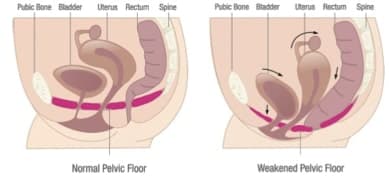
The pelvic floor muscles are a supportive basin of muscle attached to the pelvic bones by connective tissue to support the vagina, uterus, bladder and bowel. The main group of muscles providing this support is called the ‘levator’ muscles. There are also nerves that relax or squeeze these pelvic muscles as needed.
Between the levator muscles there is an opening that allows the urethra, vagina and back passage to exit the abdomen. This is called the ‘levator hiatus’.
What Happens to the Levator Ani During Childbirth?
During a vaginal birth, the baby needs to pass through the ‘levator hiatus’ in the pelvic floor, and the muscles, connective tissues and nerves can be damaged in the process. The levator muscles are stretched by 1.5 to more than 3 times their normal length as the baby passes through, depending on the size of both baby and pelvic floor muscle opening.In many women, these muscles return to normal but in 10-30% of women the muscles are overstretched or sometimes torn off the bone. This injury is called a ‘levator avulsion’
Risk factors associated with Levator ani avulsion:
- Greater size of a baby
- Prolonged second stage labour
- Maternal age
- Baby position
- Forceps delivery

Symptoms:
- Pelvic heaviness or pressure (Do you feel like your insides are falling out?). This is often worse at the end of the day or during/immediately after exercise.
- Decreased sexual desire, arousal, or ability or orgasm
- Limited sensory awareness
- Vaginal wall laxity
- Pelvic floor muscle weakness (may present as one sided weakness if the avulsion tear is unilateral)
Diagnosis :
Doctors and pelvic health / pregnancy physiotherapists who specialise in treating pelvic floor problems can detect injury through physical examination and/or pelvic ultrasound. A 4D pelvic floor ultrasound by a specially trained clinician is the best method for seeing pelvic floor structures.
Physiotherapy Treatment for Levator Ani Avulsion
- A thorough pelvic exam to assess remaining muscle strength, length, endurance and motor control.
- An assessment of your prolapse.
- Real time feedback on the quality of your pelvic floor contraction to help improve function of your pelvic floor muscles, and support to your organs.
- Determining if you may benefit from an external supportive device like a pessary.
- Personally fit you for a pessary or refer you to a provider who can if they cannot.
- Teach you pressure management strategies to reduce any unwanted stress on your tissues with daily activity or exercise.
- Provide guidance on how to safely continue your desired exercise without further injury to your tissues.
To book an initial assessment with a Women's Health physio, please contact Reception.
 WISHING EVERYONE A HAPPY NEW YEAR! WE'VE RETURNED TO OUR REGULAR OPENING HOURS
WISHING EVERYONE A HAPPY NEW YEAR! WE'VE RETURNED TO OUR REGULAR OPENING HOURS